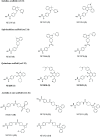Effects of structurally distinct human HDAC6 and HDAC6/HDAC8 inhibitors against S. mansoni larval and adult worm stages
- PMID: 38416775
- PMCID: PMC10927086
- DOI: 10.1371/journal.pntd.0011992
Effects of structurally distinct human HDAC6 and HDAC6/HDAC8 inhibitors against S. mansoni larval and adult worm stages
Abstract
Schistosomiasis is a major neglected parasitic disease that affects more than 240 million people worldwide caused by Platyhelminthes of the genus Schistosoma. The treatment of schistosomiasis relies on the long-term application of a single safe drug, praziquantel (PZQ). Unfortunately, PZQ is very effective on adult parasites and poorly on larval stage and immature juvenile worms; this can partially explain the re-infection in endemic areas where patients are likely to host parasites at different developmental stages concurrently. Moreover, the risk of development of drug resistance because of the widespread use of a single drug in a large population is nowadays a serious threat. Hence, research aimed at identifying novel drugs to be used alone or in combination with PZQ is needed. Schistosomes display morphologically distinct stages during their life cycle and epigenetic mechanisms are known to play important roles in parasite growth, survival, and development. Histone deacetylase (HDAC) enzymes, particularly HDAC8, are considered valuable for therapeutic intervention for the treatment of schistosomiasis. Herein, we report the phenotypic screening on both larvae and adult Schistosoma mansoni stages of structurally different HDAC inhibitors selected from the in-house Siena library. All molecules have previously shown inhibition profiles on human HDAC6 and/or HDAC8 enzymes. Among them we identified a quinolone-based HDAC inhibitor, NF2839, that impacts larval and adult parasites as well as egg viability and maturation in vitro. Importantly, this quinolone-based compound also increases histone and tubulin acetylation in S. mansoni parasites, thus representing a leading candidate for the development of new generation anti-Schistosoma chemotherapeutics.
Copyright: © 2024 Gimmelli et al. This is an open access article distributed under the terms of the Creative Commons Attribution License, which permits unrestricted use, distribution, and reproduction in any medium, provided the original author and source are credited.
Conflict of interest statement
The authors have declared that no competing interests exist.
Figures






Similar articles
-
Identification of novel multi-stage histone deacetylase (HDAC) inhibitors that impair Schistosoma mansoni viability and egg production.Parasit Vectors. 2018 Dec 27;11(1):668. doi: 10.1186/s13071-018-3268-8. Parasit Vectors. 2018. PMID: 30587243 Free PMC article.
-
Screening and Phenotypical Characterization of Schistosoma mansoni Histone Deacetylase 8 (SmHDAC8) Inhibitors as Multistage Antischistosomal Agents.ACS Infect Dis. 2020 Jan 10;6(1):100-113. doi: 10.1021/acsinfecdis.9b00224. Epub 2019 Nov 12. ACS Infect Dis. 2020. PMID: 31661956
-
Phenotypic Screening of Histone Deacetylase (HDAC) Inhibitors against Schistosoma mansoni.ChemMedChem. 2022 Sep 16;17(18):e202100622. doi: 10.1002/cmdc.202100622. Epub 2022 Aug 19. ChemMedChem. 2022. PMID: 35983937
-
Resistance of Schistosoma mansoni to praziquantel: is there a problem?Trans R Soc Trop Med Hyg. 2002 Sep-Oct;96(5):465-9. doi: 10.1016/s0035-9203(02)90405-0. Trans R Soc Trop Med Hyg. 2002. PMID: 12474468 Review.
-
Praziquantel: An update on the mechanism of its action against schistosomiasis and new therapeutic perspectives.Mol Biochem Parasitol. 2022 Nov;252:111531. doi: 10.1016/j.molbiopara.2022.111531. Epub 2022 Nov 11. Mol Biochem Parasitol. 2022. PMID: 36375598 Review.
Cited by
-
Optimizing the therapeutic benefits of synriam combined with praziquantel in mice harbouring juvenile and mature Schistosoma mansoni.Sci Rep. 2025 Aug 7;15(1):28867. doi: 10.1038/s41598-025-14037-5. Sci Rep. 2025. PMID: 40775423 Free PMC article.
References
MeSH terms
Substances
LinkOut - more resources
Full Text Sources

